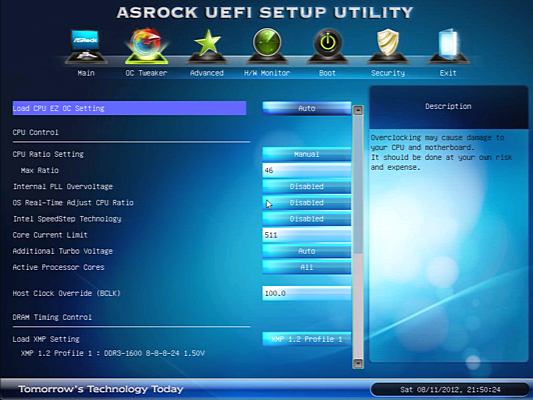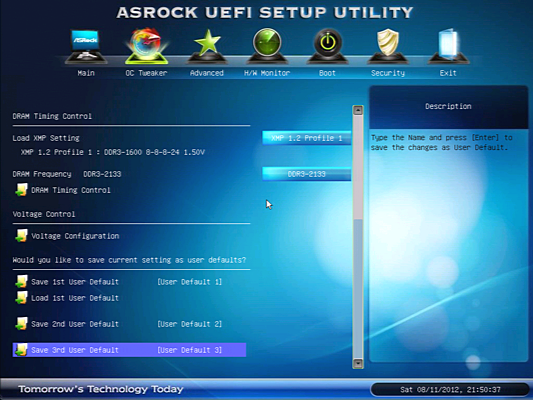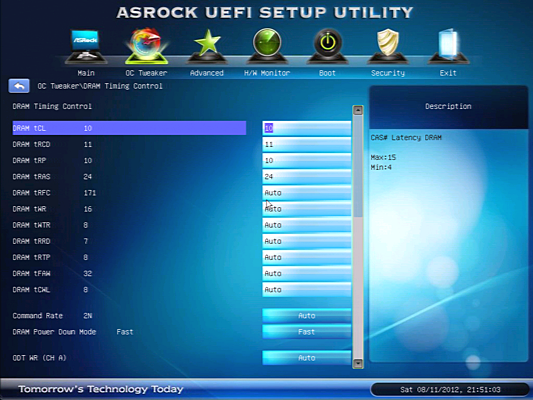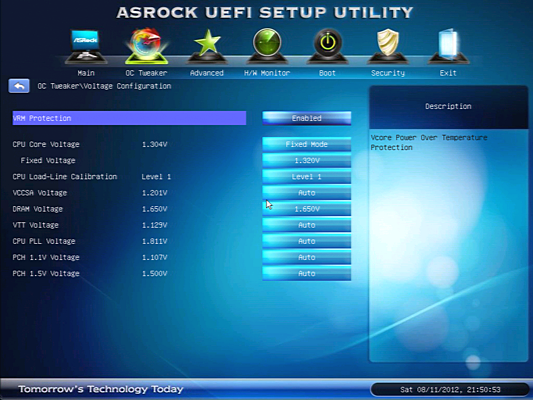System Builder Marathon, August 2012: $2000 Performance PC
Getting Our Core i7-3930K To 4.6 GHz
We began our CPU overclocking by setting what we felt was a maximum safe voltage, and then trying to find the highest possible stable frequency at that voltage. Jumping up to the 47x CPU multiplier created instability, as did choosing a 101 MHz base clock with a 46x multiplier. We had to settle for a flat 4.60 GHz.
While our memory’s XMP-1600 CAS 8 profile worked as intended, ASRock’s X79 Extreme4 automatically loosened timings when we increased the memory multiplier beyond its XMP rating. This allowed us to choose DDR3-2133 with minimum fuss.
After a few sessions of stability testing, we were able to manually tighten some of the memory timings that the motherboard had automatically relaxed in response to our higher data rate. The board selected 11-11-11-32 timings at DDR3-2133, but we found latencies of 10-11-10-24 to be stable.
Getting to CAS 10 was important to us, since CAS 11 would have resulted in a slightly slower-than-rated response time. Since DDR3-1600 CAS 8 and DDR3-2000 CAS 10 have the same response time, our memory tuning efforts should increase both bandwidth and quickness.
Though we weren’t able to push our CPU frequency higher than 4.60 GHz, we were able to save some wattage by backing down our voltage selection to 1.32 V.
Get Tom's Hardware's best news and in-depth reviews, straight to your inbox.
Current page: Getting Our Core i7-3930K To 4.6 GHz
Prev Page Assembling Our $2000 Performance PC Next Page Pushing GeForce GTX 670 To Its Limit-
Darkerson Interesting setup. I would have favored a way beefier single GPU or a nice dual GPU setup, but I mainly only game, and dont do a lot of encoding or whatnot.Reply -
Reply
The contest opens on August 20, 2012 9:00 PM PDT and closes on September 3, 2012 9:00 PM PDT.
So... i notice now that it opens at August 20, not August 19 when the $500 SBM appeared. I submitted my entry at August 19 10:30 PM. So that means that i haven't entered into the sweepstakes, or did i? I am confused, cause only one entry can be accepted. -
sarinaide i5-3570k/i7-3770kReply
Gigabyte G1 Assassin Z77
120GB SSD
500GB HDD
2xGTX 670
2x4GB DDR3 1866
And still probably cheaper with obviously better performance. -
Crashman sarinaidei5-3570k/i7-3770kGigabyte G1 Assassin Z77120GB SSD500GB HDD2xGTX 6702x4GB DDR3 1866And still probably cheaper with obviously better performance.Probably not, unless you're only testing games. But we should probably test that anyway. Does anyone else want to see it?Reply -
Crashman zander1983Ditch the BR Writer, get a BR combo drive and save yourself $60Sorry, I don't see any combo drives for $30 so the savings would be much less than $60. Plus, you'd lose BD-RE backup capability, which can be handy.Reply
-
sarinaide CrashmanProbably not, unless you're only testing games. But we should probably test that anyway. Does anyone else want to see it?Reply
It would be very interesting, the IvyBridge chips in productivity numbers hold quite well with the SB-E chips that is the only area which should be a contest. -
crisan_tiberiu 16GB ram pointless imo. 2 TB 5400rpm hdd? ...i rather get a 1 TB 7200 rpm hdd. i7 3970k ... i rather get the i7 3770k. From theese i would squeeze in a gtx 680.Reply





